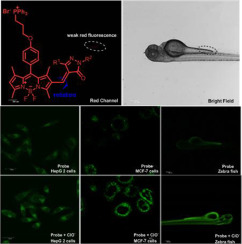Dyes and Pigments ( IF 4.5 ) Pub Date : 2018-09-26 , DOI: 10.1016/j.dyepig.2018.09.063 Chao Xu , Ying Qian

|
Fluorescent sensors have been the most commonly applied with drug discovery projects and delivery systems, as well as screening the chemical catalysts in synthetic chemistry. α, β-unsaturated pyrazolone and its derivatives have been widely developed in medicinal chemistry and in synthetic chemistry. Hence, a novel fluorescent sensor BODIPY-Pyra was explored based on α, β-unsaturated pyrazolone and BODIPY fluorophore. BODIPY-Pyra had a weak red emission (600 nm) because of rotation of CC bond. However, an enviromental restriction of TICT promoted the red fluorescence enhancement in glyceryl alcohol. Especially, α, β-unsaturated pyrazolone skeleton presented the good reactivity, which afforded the fluorescent change of BODIPY-Pyra through the chemical reaction. It's beneficial for monitoring drug delivery and chemical reaction based on C
C associated and stimulated linker by fluorescence assay. To explore the potential application of BODIPY-Pyra, the response towards hypochlorite was studied as a model in cancer cells and zebra fish. The results showed that BODIPY-Pyra could respond selectively and sensitively (LOD = 172 nM) towards hypochlorite among ROS and RSS. A 320 folds fluorescent enhancement at 520 nm was observed within 60s. Moreover, it could detect the intracellular hypochlorite in cancer cells, even endogenous hypochlorite in living zebra fish without drug induction. Noteworthy, the fluorescent sensor BODIPY-Pyra might provide a potential platform by fluorescent assays to the HTS of prodrug and chemical catalyst by the chemical reaction of unsaturated pyrazolone skeleton.
中文翻译:

基于α,β-不饱和吡唑啉酮的红色发光荧光传感器及其在癌细胞和斑马鱼中实时监测次氯酸盐的应用
荧光传感器已最常用于药物发现项目和输送系统,以及筛选合成化学中的化学催化剂。α,β-不饱和吡唑啉酮及其衍生物在药物化学和合成化学中得到了广泛的发展。因此,基于α,β-不饱和吡唑啉酮和BODIPY荧光团,探索了一种新型的荧光传感器BODIPY-Pyra。由于C的旋转,BODIPY-Pyra的红色发射很弱(600 nm)C键。然而,TICT的环境限制促进了甘油醇中红色荧光的增强。特别地,α,β-不饱和吡唑啉酮骨架表现出良好的反应性,通过化学反应提供了BODIPY-Pyra的荧光变化。对于基于C的药物输送和化学反应的监控非常有用
C通过荧光测定法关联并刺激了接头。为了探索BODIPY-Pyra的潜在应用,研究了对次氯酸盐的反应作为癌细胞和斑马鱼中的模型。结果表明,BODIPY-Pyra可以选择性和敏感地响应ROS和RSS中的次氯酸盐(LOD = 172 nM)。在60秒内观察到520 nm处的荧光增强了320倍。而且,它可以检测癌细胞中的细胞内次氯酸盐,甚至可以检测活斑马鱼中的内源性次氯酸盐而无需药物诱导。值得注意的是,荧光传感器BODIPY-Pyra可能通过不饱和吡唑啉酮骨架的化学反应,通过荧光分析为前药和化学催化剂的高温超导提供潜在的平台。


























 京公网安备 11010802027423号
京公网安备 11010802027423号